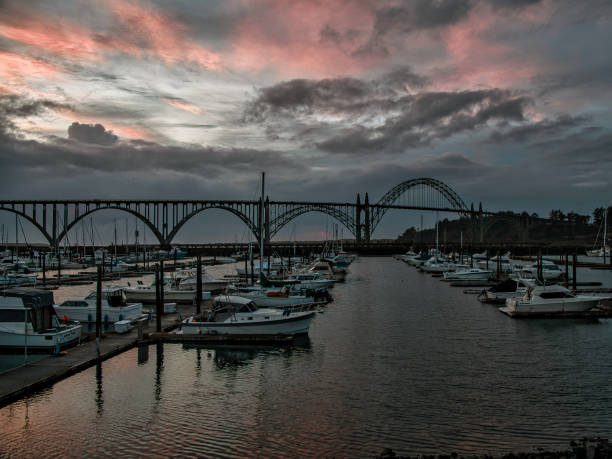How to Read the Tides for Better Fishing in Newport, Oregon
Fishing in Newport is an exciting and rewarding experience, but understanding the tides is crucial for maximizing your success. The ocean’s tides influence fish behavior, feeding patterns, and accessibility to prime fishing spots. Whether you’re targeting salmon in the bay, surf fishing along the coastline, or crabbing in Yaquina Bay, mastering tidal movements will give you a significant advantage.
This comprehensive guide will help you understand how tides work, how they impact fishing in Newport, and how you can use this knowledge to improve your catch rates.

Understanding Tides and Their Effect on Fishing in Newport
Tides are the rise and fall of sea levels caused by the gravitational pull of the moon and the sun. They follow a predictable cycle, creating periods of high tide and low tide. These tidal changes influence fish movements and feeding habits, making some times more productive for fishing than others.
Newport, Oregon, experiences semi-diurnal tides, meaning there are two high tides and two low tides each day. Knowing when these tides occur and how they affect local fish behavior is key to improving your fishing success.
Types of Tides and Their Impact on Fishing
- High Tide
- High tide occurs when the water level reaches its peak, covering more ground and flooding shallow areas.
- Fish move into shallower waters to feed, taking advantage of newly submerged food sources such as crustaceans, baitfish, and insects.
- Bays and estuaries, such as Yaquina Bay, experience increased fish activity as species move in with the rising water.
- Predatory fish take advantage of higher water levels to ambush prey in previously inaccessible areas, creating excellent fishing opportunities.
- Fishing from piers, docks, and jetty structures is particularly effective during high tide as fish move closer to man-made structures for cover and feeding.
- Low Tide
- Low tide occurs when the water level recedes to its lowest point, exposing sandbars, tide pools, and rocky structures.
- Fish tend to retreat to deeper waters, making it less productive for shore fishing but ideal for targeting fish in channels and drop-offs.
- Exposed sandbars and tide pools create excellent conditions for clamming and crabbing, as crustaceans and shellfish become more accessible.
- Fishing in Newport during low tide can be challenging, but anglers who understand where fish move during these times can still find success by targeting deeper pockets and shaded areas.
- Estuaries and river mouths can still be productive, as fish gather in deeper pools waiting for the tide to return.
- Incoming Tide (Flood Tide)
- This is the period when the tide is rising from low to high, gradually flooding estuaries, beaches, and coastal structures.
- Fish become more active as food sources are pushed toward shorelines and estuaries, making this a prime time for fishing.
- Surf fishing, pier fishing, and estuary fishing are highly productive during this time, as fish take advantage of increasing water levels.
- In Yaquina Bay, species like perch, salmon, and rockfish move into shallower areas to hunt for food being carried in by the current.
- Crabbing is also excellent during an incoming tide, as crabs become more active with the influx of fresh water and food particles.
- Outgoing Tide (Ebb Tide)
- This is the period when the tide is receding from high to low, pulling water and baitfish back into deeper waters.
- Many fish follow the receding water to deeper areas, making deeper channels, inlets, and jetty areas prime spots.
- Baitfish and crustaceans are swept out to sea, attracting predatory fish such as lingcod, striped bass, and rockfish.
- Fishing in Newport during the ebb tide is productive near river mouths, jetties, and sloping beaches where fish wait to ambush retreating prey.
- Strong currents created by an outgoing tide can make it more challenging to fish, so using heavier tackle and weighted rigs can be beneficial.

How to Use Tide Charts for Fishing in Newport
Tide charts provide essential information about the daily tidal schedule, including high and low tide times, tidal heights, and moon phases. Using these charts can help you plan your fishing trips more effectively.
How to Read a Tide Chart
- High and Low Tide Times: Look for the times when the tide peaks and recedes, as these are crucial for predicting fish movement.
- Tidal Range: The difference in water level between high and low tide. A larger range indicates stronger currents, which can improve fish activity.
- Moon Phases: New and full moons create stronger tides (spring tides), while quarter moons produce weaker tides (neap tides). Spring tides bring more dramatic water movement, influencing fish activity more significantly.
- Local Tide Conditions: Be aware that local wind patterns, coastal topography, and weather conditions can slightly alter the predicted tide levels.
You can find tide charts for fishing in Newport online, through local bait shops, or via mobile apps like Tide Alert or NOAA Tide Predictions.
Best Fishing Locations in Newport Based on Tides
Yaquina Bay
- Best during incoming and high tides, when fish move in to feed.
- Great for crabbing, clamming, and catching rockfish and perch.
- Fishing near the jetties is particularly productive during an ebb tide, as baitfish are swept through the channels.
Agate Beach (Surf Fishing)
- Best during an incoming tide when fish move into the surf zone to feed on small crustaceans and baitfish.
- Target surf perch, striped bass, and other coastal species using sand crabs and shrimp as bait.
- Early mornings and late afternoons are the most productive times.
Newport Jetty
- Ideal during an outgoing tide, as predatory fish hunt baitfish moving out to sea.
- Great for catching lingcod, rockfish, and salmon, especially near deeper drop-offs.
- Heavy tackle and strong lines are recommended due to the strong currents and rocky terrain.
Big Creek Reservoir
- Less affected by tides, making it a great freshwater alternative for fishing at any time of day.
- Best times are early morning and late evening, when fish are most active.
- Stocked regularly with trout, offering a consistent fishing experience year-round.

Fishing in Newport is a rewarding experience, but understanding tidal movements can significantly improve your success. By learning how to read tide charts, adjusting your fishing strategies based on tidal conditions, and selecting the best locations at the right times, you can increase your chances of a great catch. Whether you’re surf fishing, crabbing in the bay, or angling from a pier, mastering the tides will make your fishing trips more productive and enjoyable.
Let’s Get Started

